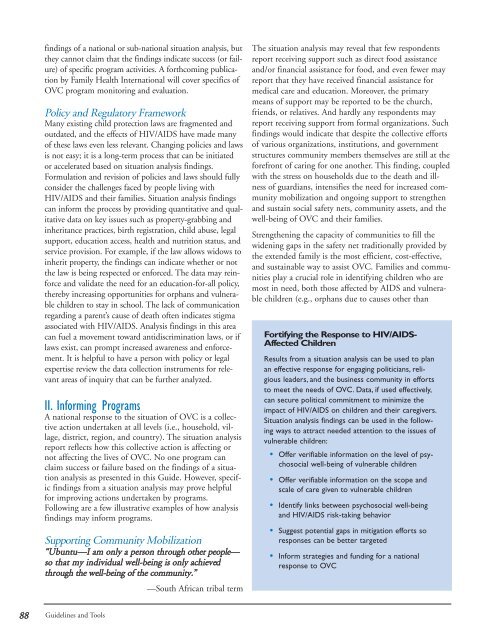Conducting a Participatory Situation Analysis of.pdf - Global HIV ...
Conducting a Participatory Situation Analysis of.pdf - Global HIV ...
Conducting a Participatory Situation Analysis of.pdf - Global HIV ...
You also want an ePaper? Increase the reach of your titles
YUMPU automatically turns print PDFs into web optimized ePapers that Google loves.
findings <strong>of</strong> a national or sub-national situation analysis, but<br />
they cannot claim that the findings indicate success (or failure)<br />
<strong>of</strong> specific program activities. A forthcoming publication<br />
by Family Health International will cover specifics <strong>of</strong><br />
OVC program monitoring and evaluation.<br />
Policy and Regulatory Framework<br />
Many existing child protection laws are fragmented and<br />
outdated, and the effects <strong>of</strong> <strong>HIV</strong>/AIDS have made many<br />
<strong>of</strong> these laws even less relevant. Changing policies and laws<br />
is not easy; it is a long-term process that can be initiated<br />
or accelerated based on situation analysis findings.<br />
Formulation and revision <strong>of</strong> policies and laws should fully<br />
consider the challenges faced by people living with<br />
<strong>HIV</strong>/AIDS and their families. <strong>Situation</strong> analysis findings<br />
can inform the process by providing quantitative and qualitative<br />
data on key issues such as property-grabbing and<br />
inheritance practices, birth registration, child abuse, legal<br />
support, education access, health and nutrition status, and<br />
service provision. For example, if the law allows widows to<br />
inherit property, the findings can indicate whether or not<br />
the law is being respected or enforced. The data may reinforce<br />
and validate the need for an education-for-all policy,<br />
thereby increasing opportunities for orphans and vulnerable<br />
children to stay in school. The lack <strong>of</strong> communication<br />
regarding a parent’s cause <strong>of</strong> death <strong>of</strong>ten indicates stigma<br />
associated with <strong>HIV</strong>/AIDS. <strong>Analysis</strong> findings in this area<br />
can fuel a movement toward antidiscrimination laws, or if<br />
laws exist, can prompt increased awareness and enforcement.<br />
It is helpful to have a person with policy or legal<br />
expertise review the data collection instruments for relevant<br />
areas <strong>of</strong> inquiry that can be further analyzed.<br />
II. Informing Programs<br />
A national response to the situation <strong>of</strong> OVC is a collective<br />
action undertaken at all levels (i.e., household, village,<br />
district, region, and country). The situation analysis<br />
report reflects how this collective action is affecting or<br />
not affecting the lives <strong>of</strong> OVC. No one program can<br />
claim success or failure based on the findings <strong>of</strong> a situation<br />
analysis as presented in this Guide. However, specific<br />
findings from a situation analysis may prove helpful<br />
for improving actions undertaken by programs.<br />
Following are a few illustrative examples <strong>of</strong> how analysis<br />
findings may inform programs.<br />
Supporting Community Mobilization<br />
“Ubuntu—I am only a person through other people—<br />
so that my individual well-being is only achieved<br />
through the well-being <strong>of</strong> the community.”<br />
—South African tribal term<br />
The situation analysis may reveal that few respondents<br />
report receiving support such as direct food assistance<br />
and/or financial assistance for food, and even fewer may<br />
report that they have received financial assistance for<br />
medical care and education. Moreover, the primary<br />
means <strong>of</strong> support may be reported to be the church,<br />
friends, or relatives. And hardly any respondents may<br />
report receiving support from formal organizations. Such<br />
findings would indicate that despite the collective efforts<br />
<strong>of</strong> various organizations, institutions, and government<br />
structures community members themselves are still at the<br />
forefront <strong>of</strong> caring for one another. This finding, coupled<br />
with the stress on households due to the death and illness<br />
<strong>of</strong> guardians, intensifies the need for increased community<br />
mobilization and ongoing support to strengthen<br />
and sustain social safety nets, community assets, and the<br />
well-being <strong>of</strong> OVC and their families.<br />
Strengthening the capacity <strong>of</strong> communities to fill the<br />
widening gaps in the safety net traditionally provided by<br />
the extended family is the most efficient, cost-effective,<br />
and sustainable way to assist OVC. Families and communities<br />
play a crucial role in identifying children who are<br />
most in need, both those affected by AIDS and vulnerable<br />
children (e.g., orphans due to causes other than<br />
Fortifying the Response to <strong>HIV</strong>/AIDS-<br />
Affected Children<br />
Results from a situation analysis can be used to plan<br />
an effective response for engaging politicians, religious<br />
leaders, and the business community in efforts<br />
to meet the needs <strong>of</strong> OVC. Data, if used effectively,<br />
can secure political commitment to minimize the<br />
impact <strong>of</strong> <strong>HIV</strong>/AIDS on children and their caregivers.<br />
<strong>Situation</strong> analysis findings can be used in the following<br />
ways to attract needed attention to the issues <strong>of</strong><br />
vulnerable children:<br />
• Offer verifiable information on the level <strong>of</strong> psychosocial<br />
well-being <strong>of</strong> vulnerable children<br />
• Offer verifiable information on the scope and<br />
scale <strong>of</strong> care given to vulnerable children<br />
• Identify links between psychosocial well-being<br />
and <strong>HIV</strong>/AIDS risk-taking behavior<br />
• Suggest potential gaps in mitigation efforts so<br />
responses can be better targeted<br />
• Inform strategies and funding for a national<br />
response to OVC<br />
88<br />
Guidelines and Tools















